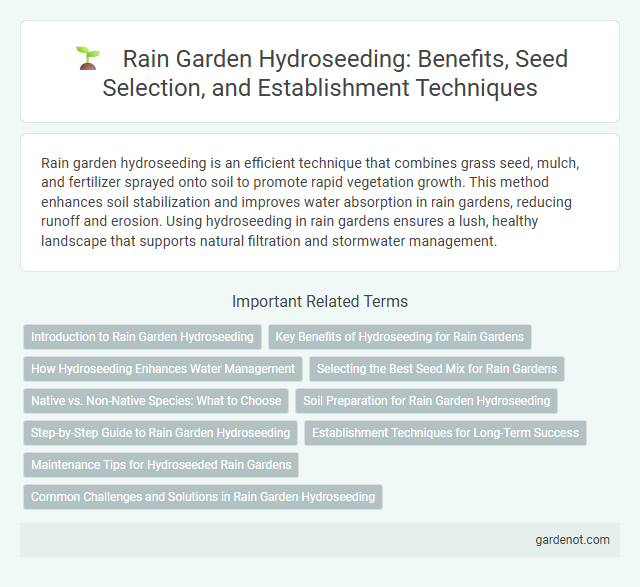Rain garden hydroseeding is an efficient technique that combines grass seed, mulch, and fertilizer sprayed onto soil to promote rapid vegetation growth. This method enhances soil stabilization and improves water absorption in rain gardens, reducing runoff and erosion. Using hydroseeding in rain gardens ensures a lush, healthy landscape that supports natural filtration and stormwater management.
Introduction to Rain Garden Hydroseeding
Rain garden hydroseeding is an efficient technique combining seed, mulch, fertilizer, and water to promote rapid vegetation growth within rain gardens, enhancing stormwater management and soil stabilization. This method ensures uniform seed distribution and minimizes erosion, which is crucial for maintaining the rain garden's ability to filter pollutants and reduce runoff. By improving plant establishment rates, hydroseeding supports the ecological function and aesthetic value of rain gardens in urban and suburban landscapes.
Key Benefits of Hydroseeding for Rain Gardens
Hydroseeding in rain gardens offers rapid and uniform vegetation establishment, significantly reducing soil erosion and runoff while enhancing water absorption. The technique promotes deep root growth, which stabilizes soil and improves filtration of stormwater pollutants. Cost-effective and efficient for large or irregularly shaped rain gardens, hydroseeding ensures resilient and sustainable green infrastructure.
How Hydroseeding Enhances Water Management
Hydroseeding in rain gardens promotes rapid vegetation establishment, improving soil stability and reducing erosion by creating a dense root network. This method enhances water infiltration and absorption, minimizing surface runoff and decreasing the risk of flooding. The even distribution of seeds and mulch in hydroseeding optimizes nutrient retention, supporting healthier plant growth and more effective stormwater management.
Selecting the Best Seed Mix for Rain Gardens
Selecting the best seed mix for rain gardens is crucial for maximizing water absorption and promoting native biodiversity. A seed mix should include deep-rooted native grasses and wildflowers such as switchgrass, blue wild indigo, and black-eyed Susan, which enhance soil stability and filtration. Choosing drought-tolerant and erosion-resistant species tailored to local climate and soil conditions ensures the rain garden's long-term effectiveness and ecological health.
Native vs. Non-Native Species: What to Choose
Choosing native species for rain garden hydroseeding enhances water absorption and supports local wildlife, ensuring ecological balance and long-term garden health. Non-native species may offer aesthetic variety but often require more maintenance and risk disrupting local ecosystems. Prioritizing native plants maximizes soil stabilization, reduces erosion, and promotes sustainable stormwater management.
Soil Preparation for Rain Garden Hydroseeding
Effective soil preparation for rain garden hydroseeding involves thorough loosening and amending with organic matter to enhance water infiltration and nutrient retention. Screening soil to remove debris and grading the surface to direct runoff ensures optimal seed-to-soil contact and prevents erosion. Proper soil pH adjustment and moisture content regulation are critical to support rapid germination and healthy growth of native rain garden plants.
Step-by-Step Guide to Rain Garden Hydroseeding
Hydroseeding a rain garden begins by preparing the soil, ensuring it is loosened and free of debris to promote optimal seed germination. Next, mix a specialized hydroseeding slurry composed of native grass seeds, mulch, fertilizer, and water in the hydroseeder tank for uniform application. Finally, evenly spray the mixture over the rain garden area and maintain consistent moisture levels to support seedling establishment and effective stormwater absorption.
Establishment Techniques for Long-Term Success
Rain garden hydroseeding utilizes a precise blend of native seed mixtures, mulch, and tackifiers to ensure rapid germination and soil stabilization. Incorporating soil amendments and proper site preparation enhances nutrient retention and water infiltration, promoting robust plant establishment. Regular monitoring and adaptive maintenance practices support long-term resilience against erosion and runoff.
Maintenance Tips for Hydroseeded Rain Gardens
Maintaining hydroseeded rain gardens requires consistent watering during the first few weeks to ensure seed germination and root establishment. Regular inspection for erosion, patchy growth, or invasive weeds helps preserve the garden's effectiveness in stormwater management. Applying mulch and periodic fertilization promotes healthy vegetation development, enhancing the rain garden's filtration capabilities and overall sustainability.
Common Challenges and Solutions in Rain Garden Hydroseeding
Rain garden hydroseeding often faces challenges such as soil erosion, seed washout, and poor germination due to uneven water distribution or heavy rainfall. Solutions include using erosion control blankets, selecting drought-resistant native plant seeds, and applying mulch to retain moisture and protect seeds. Proper site preparation and timing of hydroseeding during optimal weather conditions enhance seed establishment and long-term rain garden success.
Rain garden hydroseeding Infographic

 gardenot.com
gardenot.com